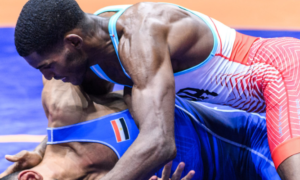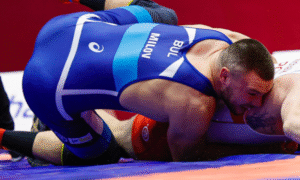The time has passed for feelings of disappointment if you are the United States Greco-Roman program. There is no choice but for the page to turn and to begin driving full speed ahead at accomplishing the objective that still hangs in the air after a long flight home from Kazakhstan.
Make no mistake about it, the inability to qualify even just one weight class for Tokyo 2020 in Nur-Sultan is a deflating fact of life with which the US is forced to reconcile until March, when its second chance arrives in Ottawa.
A little perspective is called for. The US did not qualify a weight at the 2019 World Championships. But they were hardly alone. Neither did Korea. Or Azerbaijan. Or Croatia, Romania, Moldova, Finland, and about two dozen other nations that entered athletes into the tournament either hoping for or expecting a sizable ROI.
It happens. The World Championships is a hard tournament; harder still when qualifying for an Olympiad is on the line. Nothing new here.
Soon enough, the prospect of qualifying weights will ease into the background for just a little while as the floodgates open in the non-Olympic categories. The result will offer plenty of conversation fodder to digest (a quick glance at what 60 and 77 kilograms may look like domestically before the year is out is a good start). Athletes who have been on the shelf due to injury will also return, and competitions held prior to March are going to render hypothetical baselines many will apply towards fun but foolhardy predictive analysis.
The focus will once again become what happens on the mat, not what didn’t.
For Comparison’s Sake
Touting and/or comparing and contrasting individual records between one World event and another is not an entirely accurate exercise, of course, since the majority of variables differ. There is World Team turnover, the draws are not the same (nor are the rules in one case), and a multitude of intangibles exist which cannot be accounted for with any reasonable amount of assuredness.
That being said, 2017 is an appropriate starting line since Paris was the first World tournament of the quad. Now — the rule-set was different (no ordered par terre with phantom passives running the show) and scoring was down (troublingly so). There were also two less weight classes. But performance is performance, and bookkeeping, bookkeeping.
2017 World Championships USA Results
- Overall individual record: 5-9
- One win via tech fall; one win via fall (courtesy of Ellis Coleman, 66 kg and Robby Smith, 130, respectively).
- One wrestler lost via tech fall (G’Angelo Hancock, 98 kg, to Artur Aleksanyan, ARM).
- No US wrestler competed in a quarterfinal bout.
- Only one wrestler competed in a repechage bout (Hancock).
- Team USA finished in 31st place.
2018 World Championships USA Results
- Overall individual record: 7-11
- One win via tech fall; five wins via fall (Kamal Bey, 77 kg, had the tech; Coleman notched one pin; and Adam Coon, 130 kg, had four pins).
- Two wrestlers lost via tech fall (Sam Hazewinkel, 55 kg, to Ekrem Ozturk, TUR; Dalton Roberts, 60 kg, to Etienne Kinsinger, GER).
- One wrestler competed in a quarterfinal bout (Coon).
- Coleman competed in a repechage bout; Coon advanced to a medal match (finals).
- Team USA finished in 17th place.
2019 World Championships USA Results
- Overall individual record: 8-12
- Four wins via tech fall (Max Nowry, 55 kg, two; Ryan Mango, 63 kg, one; and Coleman, 67 kg, one).
- Three wrestlers lost via tech fall (Nowry to Eldaniz Azizli, AZE; John Stefanowicz, 82 kg, to Haito Qian, CHN; Joe Rau, 87 kg, to Mikalai Stadub, BLR).
- Two wrestlers competed in a quarterfinal bout (Nowry and Ray Bunker, 72 kg).
- Two wrestlers competed in a repechage bout (Nowry and John Stefanowicz, 82 kg).
- Nowry competed in a medal match (bronze medal round).
- Team USA finished in 20th place.
2017’s scoring results demand dismissal due to that tournament’s astonishingly-low average score per match — which in turn calls into question items such as average points per win, and conversely, per loss. For instance, in ’17 the average points yield per US win was 5, and the average points yield per opponent win was 5.5. The majority of these points were awarded due to passivity and step-outs, not takedowns or offensive techniques from par terre. It should also be noted that points scored prior to falls are not included, of which there were two examples (R. Smith’s pin of Tamas Soos, SLO; and Lazslo Szabo‘s, HUN, win over Cheney Haight at 80 kg).
Fast-forwarding to 2019, those numbers are drastically different, with average points per US win ballooning to 8.25 — and average points per opponent wins slightly increasing to 5.8. Important to enunciate because in ’17, ordered par terre was not a factor, and this year, it most certainly was.
Point differential, which in Greco is as skewed of a metric as there can possibly be, particularly when par terre is involved, also saw significant expansion when comparing ’17 Paris to ’19 Nur-Sultan. Again, matches ending via fall are not counted (the exact reason why ’18 is not being cited — Coon wrecked the joint).
2017
- Average point differential per US win: 4.5
- Average point differential per US loss: 3.9
2019
- Average point differential per US win: 6.75
- Average point differential per US loss: 4.9

Ryan Mango (red) used his passivity/par terre chance against Julinho Be Correia dju (POR) to roll out a quick 11-0 tech thanks to this trap-arm gutwrench. (Photo: Jim Thrall/MatFocus)
Par Terre for the USA at Nur-Sultan
A quick breakdown of points scored from par terre top for US athletes at the 2019 World Championships, including methodology.
*Par terre offense points in bold.
Nowry
Match 1: Takedown to four gutwrench(es) = 8
Match 3: Passivity to three gutwrenches = 6
Hafizov
Match 1: Takedown to lift = 2
Mango
Match 1: Passivity to five gutwrench(es) = 10
Bunker
Match 1: Passivity to reverse lift = 2
Rau
Match 1: Takedown to gutwrench = 2
Hancock
Match 1: Passivity to gutwrench = 2
It is more than justified to quibble with what some of these numbers mean, especially considering that in 2019, 38 of the 66 points accumulated from US victories were earned by non-Olympic weight class participants. Unfair, because it’s a line of thinking that minimizes what was accomplished by three first-time World Team members — but understandable in the context of the upcoming season’s importance.
Qualified Nations (Thus Far)
Below, find the 20 nations that have qualified Greco-Roman weight classes for the 2020 Tokyo Olympics and the athletes who got it done at the ’19 Worlds (along with their respective placings).
Armenia
77 kg: Karapet Chalyan (5th)
97 kg: Artur Aleksanyan (silver)
Belarus
87 kg: Mikalai Stadub (5th)
Cuba
67 kg: Ismael Borrero Molina (gold)
130 kg: Oscar Pino Hinds (silver)
Denmark
67 kg: Fredrik Bjerrehuus (5th)
Egypt
67 kg: Mohamed Elsayed (5th)
Estonia
130 kg: Heiki Nabi (5th)
Georgia
97 kg: Giorgi Melia (5th)
130 kg: Iakobi Kajaia (bronze)
Germany
67 kg: Frank Staebler (bronze)
87 kg: Denis Kudla (bronze)
130 kg: Eduard Popp (5th)
Hungary
77 kg: Tamas Lorincz (gold)
87 kg: Viktor Lorincz (silver)
Iran
60 kg: Ali Reza Olla Nejati (bronze)
77 kg: Mohammadali Gerei (bronze)
130 kg: Amir Mohammadali Ghasemimonjezi (5th)
Japan
60 kg: Kenichiro Fumita (gold)
Kazakhstan
60 kg: Mirambek Ainagulov (bronze)
77 kg: Ashkat Dimulkhamedov (5th)
Kyrgyzstan
87 kg: Atabek Azisbekov (5th)
Poland
97 kg: Tadeusz Michalik (5th)
Russia
60 kg: Sergey Emelin (silver)
67 kg: Artem Surkov (silver)
97 kg: Musa Evloev (gold)
Serbia
67 kg: Mate Nemes (bronze)
97 kg: Mihail Kajaia (bronze)
Sweden
77 kg: Alex Kessidis (silver)
Turkey
97 kg: Cenk Ildem (bronze)
130 kg: Riza Kayaalp (gold)
Ukraine
60 kg: Lenur Temirov (5th)
87 kg: Zhan Belenyuk (gold)
Uzbekistan
60 kg: Elmurat Tasmuradov (5th)
77 kg: Jalgasbay Berdimuratov (bronze)
87 kg: Rustam Assakalov (bronze)
First-time Senior World Champions
Nugazi Tsurtsumia (55 kg, GEO)
Shinobu Ota (63 kg, JPN)
Abuyazid Mantsigov (72 kg, RUS)
Tamas Lorincz (77 kg, HUN)
Lasha Gobadze (82 kg, GEO)
First-time Senior World Medalists
Khorlan Zhakansha (55 kg, KAZ, silver)
Shota Ogawa (55 kg, JPN, bronze)
Ali Reza Olla Nejati (60 kg, IRI, bronze)
Slavik Galstyan (63 kg, ARM, bronze)
Mate Nemes (67 kg, SRB, bronze)
Abuyazid Mantsigov (72 kg, RUS, gold)
Aram Vardanyan (72 kg, UZB, silver)
Alex Kessidis (77 kg, SWE, silver)
Jalgasbay Berdimuratov (77 kg, UZB, bronze)
Rafik Huseynov (82 kg, AZE, silver)
Haitao Qian (82 kg, CHN, bronze)
Iakobi Kajaia (130 kg, GEO, bronze)
Two More World Events in 2019
And they are both within a week of each other. First, it will be the CISM Military World Games October 21-24 in Wuhan City, China featuring several US Seniors (including Coleman) who won their weight classes at the Armed Forces Championships earlier this year.
A week later are the 2019 U23 World Championships from Budapest, Hungary. Greco action starts on Friday, November 1 and wraps the tournament up on Sunday (November 3). The U23 Worlds will be viewable in the US on Trackwrestling.com. As for the CISM Military World Games, it’s anyone’s best guess at the moment.
Remaining Senior Int’l Schedule
There are a bunch of interesting Senior events still left on the calendar this year and you might want to pay attention to most of them since there is sure to be a substantial amount of weight class fluctuation.
As for US concerns, expect participation in New York (of course), Haparanda, and Haavisto. There is also a group of athletes targeted once again for the SA Lavrikov Memorial in St. Petersburg, Russia, but that date is as of yet unconfirmed.
*Team tournament or delegation invite only.
November
Friday, November 15 — Bill Farrell Memorial/NYAC Open — New York, New York
Saturday, November 23 — Ibrahim Moustafa Tournament — Cairo, Egypt
Friday, November 29 — *Alrosa Cup — Moscow, Russia
Saturday, November 30 — Haparanda Cup — Haparanda, Sweden
Saturday, November 30-Sunday, December 1 — *World Cup — Tehran, Iran
December
Friday, December 5-Saturday, December 6 — *World Clubs Cup — Tehran, Iran
Sunday, December 7 — Haavisto Cup — Ilmajoki, Finland
Questions? Concerns? Feel like reaching out? Do so on Twitter, Facebook, and Instagram!
Listen to “5PM28: G’Angelo Hancock, Joe Rau and Max Nowry” on Spreaker.
SUBSCRIBE TO THE FIVE POINT MOVE PODCAST
iTunes | Stitcher | Spreaker | Google Play Music | RSS
















